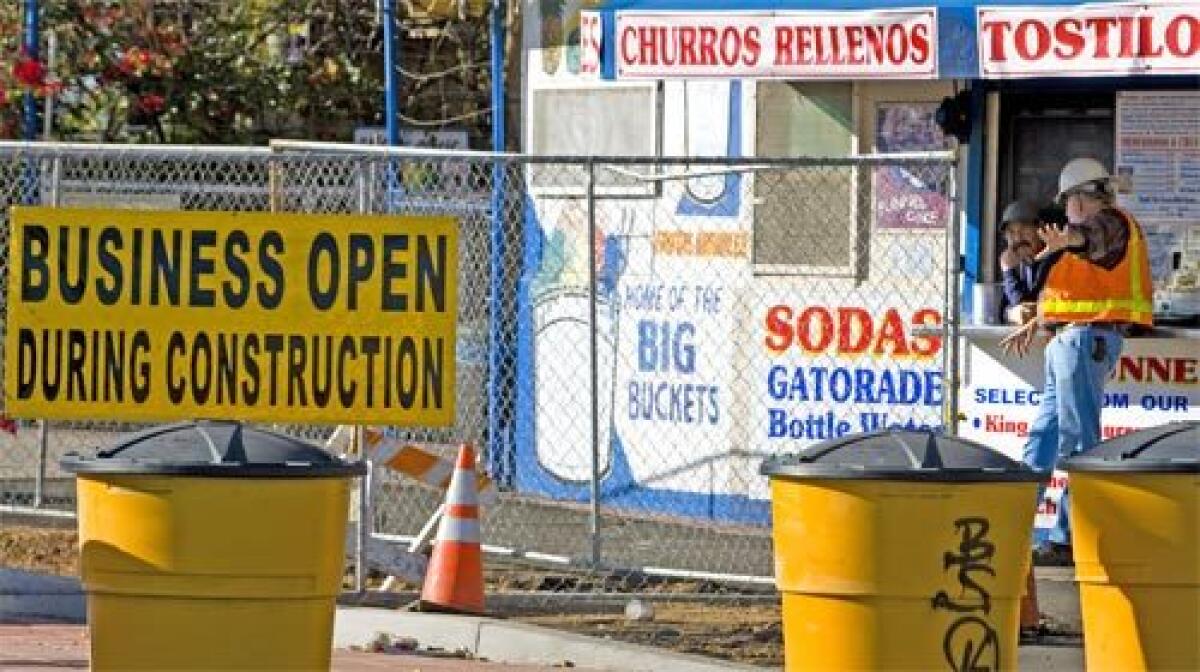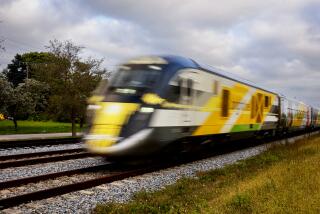Gold Line work upsets East L.A. merchants

The Gold Line extension into East Los Angeles promises to carry development and prosperity into an area long troubled by poverty and blight.
But some business owners along the neighborhood’s busy 3rd Street, where a large section of the six-mile, above-ground rail line is being built, say the roadwork and street closures have all but halted commerce in the area. Some merchants say they have been forced to skip rent payments and lay off employees. They even wonder whether they will be around to see the train whiz by.
“The worst that I can remember was the El Niño year . . . but it was nowhere as bad as this,” said Fred Lane, whose E.L.A. Hand Car Wash has been in his family for three decades, and in the neighborhood for more than half a century.
Lane said he had lost more than a third of his business since construction began last year.
“I don’t know what’s going to happen, to be honest with you,” Lane said. “I’m just trying to make it to my next mortgage payment. I’m basically running the carwash at a loss right now and begging other family members for help.”
But the pains of growth will subside -- and business will blossom -- once the tractors and bulldozers are finished and the Gold Line opens, proponents of the light rail line say. And public funds are available to help businesses through these tough times.
The $900-million project officially began more than three years ago with the burrowing of a tunnel in Boyle Heights. In East L.A., work began about a year ago along 3rd Street, where trains will glide down the center of the three-lane roadway.
When completed in 2009, the line will traverse more than 15 blocks on 3rd Street, then head north on Indiana Street before turning east onto 1st Street, eventually disappearing into a tunnel under Boyle Heights until reemerging near Little Tokyo and into Union Station. The extension will connect the neighborhoods to a 73-mile network of light rail and subway that crisscrosses the county.
But the economic damage to markets, restaurants and barbershops affected by the construction -- about 90% of the businesses are running in the red, according to Chamber of Commerce officials -- has some leaders in the area questioning the benefits of the upcoming rail line.
“The iron horse is roaring through East L.A.; it’s in the name of progress, but it really does amaze me how much of a rupture that it is going to be for East Los Angeles,” said state Sen. Gloria Romero (D-Los Angeles), whose district includes the businesses along 3rd Street. “It’s a bit frightening. You almost have to stop and think, was this the right thing to do, to run it through here?”
Romero was among a group of political leaders who fought for the Gold Line extension. Some of those who stood by her at the groundbreaking three years ago, however, still believe that the rail line ultimately will be good for the community.
“It is proven to be the case almost anywhere else where you build this kind of light rail system, it does create an opportunity for businesses to flourish,” said Los Angeles County Supervisor Gloria Molina, who represents the area.
Molina added that not everyone is unhappy: “There are businesspeople who have been there for a long time and want it to stay exactly the same, and there are others who look forward to the Gold Line.”
Yvette Robles Rapose, community relations manager for the Metropolitan Transportation Authority, the agency that is building the line, agreed.
“The only thing that’s going to be different between having no train and having a train is that there’s going to be an influx of people coming to the Eastside that have never been there before,” Robles Rapose said.
“They’re going to shop there, they’re going to eat there, and they’re going to provide opportunities that were never there before the train came,” she said.
Robles Rapose has a $250,000 advertising budget this year to help businesses let customers know that they have not closed up shop. The MTA has printed banners and fliers and even set up an online-buying website for a store that sells uniforms.
According to data provided by the county, 129 merchants in East L.A. have complained to the MTA about the loss of business since construction began. Of those, 115 businesses have accepted some help from transit officials.
“Is it inconvenient? Yes, it’s inconvenient,” Robles Rapose said. “Is it going to change the face of the community? Yes, but only for the better.”
Some business leaders, however, fear that the area’s economy won’t survive much longer -- no matter how many banners are raised or websites set up.
“I think unfortunately, a lot of these businesses are going to leave and not come back because the losses are going to be so great they’re not going to reinvest in that area,” said Gustavo Camacho of the Greater East L.A. Chamber of Commerce.
“I don’t think everyone at the end of the day comes out winning,” he said. “I don’t think it’s going to have fruitful results. In essence, it’s going to hurt local businesses in the area.”
Merchants in other parts of the city have faced similar challenges when rail-building projects rolled through their neighborhoods. In the 1990s, some businesses along Wilshire Boulevard didn’t survive subway construction through the Mid-Wilshire area. Even the Walk of Fame was damaged when workers dug under Hollywood Boulevard as they constructed the Red Line.
But merchants in East L.A. said the sting of progress is even more painful here, an area that was struggling economically before the construction started.
“The people are different, the businesses are different,” said Rocki Esparza, owner of Manny’s El Loco Restaurant. “People that have businesses here are barely surviving.”
Esparza’s fast-food Mexican eatery has been on the corner of 3rd Street and Atlantic Boulevard for 16 years, building a regular lunchtime crowd of neighborhood residents and area workers.
Large concrete barriers and small orange cones along this section of the construction zone have limited access to the restaurant’s parking lot -- turning a once lively spot where seating was scarce during peak hours into a place with plenty of empty tables.
Esparza has turned to catering events and delivering food to homes, as well as laying off two of her 10 employees.
“I think I’ve lost my customers, and I don’t really think that they’ll be back,” she said. “The only reason I’ve stayed in business is because we’ve been well-rooted. But I’ve depleted my savings, and I’m wondering about my future.”
More to Read
Start your day right
Sign up for Essential California for news, features and recommendations from the L.A. Times and beyond in your inbox six days a week.
You may occasionally receive promotional content from the Los Angeles Times.






